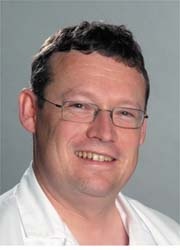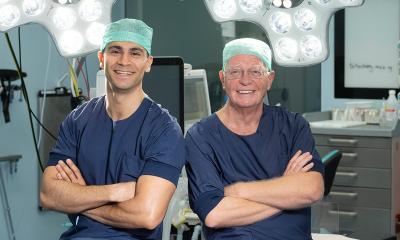Ultrasound-guided regional anaesthesia and pain therapy - a painstaking technique
Watching an ultrasound-guided needle move towards a nerve can help an anaesthetist and a pain therapist, as well as increase their success rate. Nonetheless, few physicians use this option in interventional pain therapy. Meike Lerner of European Hospital spoke with Dr Urs Eichenberger, hospital consultant and director (ad interim) of pain therapy at the anaesthesiology polyclinic, University Hospital Bern/Inselklinik, and asked why this technique is so rarely used in interventional pain therapy and what the future holds for
this technique
'Ultrasound-guided interventional pain therapy originates in ultrasound guided regional anaesthesia,' Dr Eichenberger explained.

‘The traditional method for partial anaesthesia – that is, detecting the nerve with electricity and then injecting anaesthetic – has a drawback. It shows only if the needle tip is close to the nerve. But what you really want is to transport the drug to the nerve, not the needle. With ultrasound we can visualise and localise nerves and guide the needle all the way to them, thus reducing the risk of damaging the nerve and neighboured structures. Obviously, as an anaesthetist you know where the nerves should be, but there are anatomical variations that can only be recognised with ultrasound. Moreover, you can watch the anaesthetic spread live, so to speak, and see whether it reaches the target. With the traditional method the success rate of very experienced physicians is up to 95%. With ultrasound I’m sure we can increase that rate.
‘The method was transposed to pain therapy from regional anaesthesia, and the advantages are obvious: With chronic pain patients we usually diagnostically block nerves to localise the source of the pain. Before, we did this blindly - we injected large doses of anaesthetic, up to 10 ml. With the help of ultrasound we can reduce that dose to about 1-2 ml because we can target certain nerves and don’t have to spread anaesthetic over a large area. For a patient this hopefully means better diagnosis. Furthermore, dose reduction in regional anaesthesia – where larger doses are used – means a lower risk of side effects and allows us to block several regions of interest at the same time, both arms, for example. With a dose of 40 ml per side we cannot do this – as that dose would be toxic.
‘Ultrasound-guided pain therapy is particularly interesting for very sensitive regions, such as the cervix. Very close to the targeted nerves you find a lot of different vulnerable structures. Today ultrasound can visualise small nerves down to a diameter of 1-2 mm. One example is the possible visualisation of the nerves innervating the cervical facet joints. Consequently, we can position the needle right next to the targeted nerve. The traditional method to block these nerves is based on X-ray images, which show only the neighbouring bone structure. While this gives an indication of the nerve pattern you do not recognise anatomical variations, both of the nerves and of surrounding structures you don’t want to damage.’
Why is this apparently successful method so rarely used?
‘In regional anaesthesia the method is used quite often, and in a lot of hospitals. In pain therapy the targeted nerves are smaller and therefore more difficult to detect by ultrasound. In ultrasound you recognise the very small nerves only if you have excellent anatomical knowledge and know where these nerves run. You need an experienced eye to correctly interpret the images. And we should not forget: With the exception of cardiac anaesthetists, the anaesthetists and pain therapists using this method often lack experience in reading ultrasound images. This is an entirely new field for the discipline.
‘There is also another problem in pain therapy. There are so many anatomical regions we have to deal with. In pain therapy we have too few cases for special interventions, so it’s more difficult to build up experience.
‘In some ways, ultrasound-guided work is a paradox: it facilitates the therapy, but only if you already have the necessary know-how. So, as a physician, you have to master your trade perfectly. Ultrasound will not automatically turn a physician into an excellent pain therapist – you have to be an excellent physician to begin with. Handling the technology is something that has to be learnt and exercised in seminars and workshops. In anaesthesia particularly, there’s currently a huge demand for training, and a trend towards ultrasound-guided methods, which will increase over the next few years.
‘The next step is obviously to spread the method. We are currently one of only a few centres to offer this pain therapy. In anaesthesia the situation is somewhat different. Here the method is better known, and I expect, in the future, it will be a normal procedure in all regional anaesthesia applications for which it is suitable and the rate of success could be augmented and complications could be reduced significantly.
Further details: urs.eichenberger@insel.ch
01.05.2007











